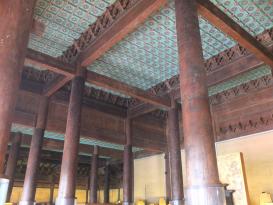My project for the Local Gazetteers workshop (August 2016) is to collect information on and map using GIS the sources of the nan-wood timbers used for the construction of the Ming dynasty (1368–1644) palaces in Beijing. The results of my research will be included in the third chapter of my book, which I will continue writing as a Visiting Scholar at the MPIWG during the 2016–2017 academic year. My book focuses on the major architectural projects of the Yongle emperor (r. 1402–1424), one of the most prolific builders in the history of China. They include the Forbidden City in Beijing; the sacrificial halls at Yongle’s tomb, Changling, a few hours north of the capital; a Daoist temple complex on Mount Wudang in central China; and a Buddhist monastery at the Sino-Tibetan frontier. These sites are important sources for understanding the official architectural style of the early Ming court, which, for reasons that have not yet been sufficiently addressed in scholarship, exhibited far greater degrees of structural simplification and standardization than ever before. While Yongle’s architectures share much in common with each other structurally, they also possess many regionally specific differences that reveal the limits of the imperial reach. In addition to the buildings themselves, my research examines a number of issues related to the construction process: How were the projects planned? Who built them? Where were the materials sourced? And what role did the emperor play in this process? As I argue, Yongle was heavily invested personally in his architectural projects and through a sustained engagement with them achieved a deeper understanding of the distant places within his empire. Similarly, his constructions established an imperial presence within these remote locales, leading to significant shifts in their cultural geographies. Finally, Yongle’s association with these great architectural projects continued to shape the public perception of him well after his death, and in this respect played a much greater role in the formation of his imperial identity than extant scholarship acknowledges.

Ling’endian, the main sacrificial hall at the tomb of the Yongle Emperor. Photography by author, 2014.
Project
(2016-2017)
Architecture and Empire in the Reign of Yongle
Publications
Campbell, A. (2019). The Hall of Supreme Harmony as a simulacrum of Ming dynasty construction. In K. M. Swope (
Read MoreEd. ), The Ming World (pp. 221-240). New York: Routledge Press.
